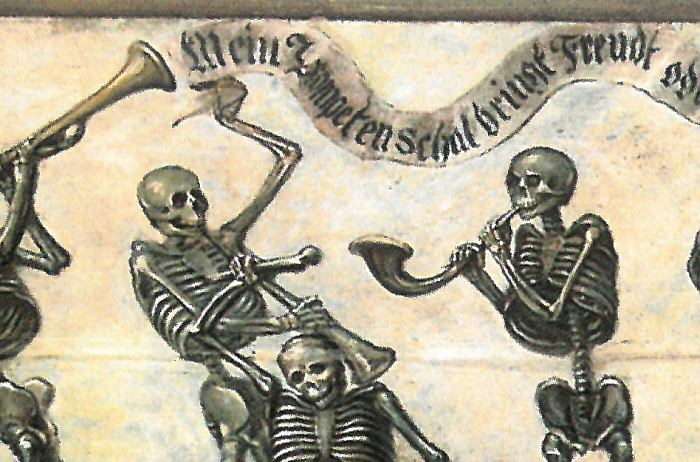

19. September 1998 – 29. November 1998
Dance of the Dead – Dance of Death
Monumental Dances of Death in the German-speaking World
Only few picture motives of the Middle Ages have remained as alive until today as the motive of the Dance of Death. Whether in the fine arts, literature, music or theater, the dialogue between the dying and the sometimes frightening figure, the Bone Man, has found ever new forms of expression.
Due to the diverse history of motifs, the Dance of Death in its monumental form is a priority for this project. The exhibition and the accompanying catalog trace the roots of this subject and follow its development through the centuries.
Monumental Dances of Death, which people used to be able to view and experience as art in public spaces on ossuaries, cemetery walls, churches and even on bridges, have developed into friezes and frescoes up to 80 meters long. Individual sequences of pictures showing people of all ages and status in dance with death reached up to 70 scenes.
The original environment of the Dances of the Dead are those places where people were buried. Places, where popular ideas were based on the "habitat of the dead", where the dead temporarily rose from their graves and made music to dance their dance or where the living were invited to the last dance.
With Holbein's Totentänzen in the 16th century, the motif of dance disappears. The dead no longer dance; instead, death as a personified skeleton now penetrates the everyday world of people and courts their favor.
In ever new ways, sometimes charming, sometimes cunningly ingratiating or even spreading fear and terror, the bone-man holds his office and brings his victims into the realm of the dead.
In addition to sketches, watercolors, and prints, which are rarely shown or are being shown for the first time and often the only evidence of the destroyed monumental Dances of the Dead, the exhibition also includes outstanding originals, such as two frescoes from the "Baseler Totentanz" from around 1440, as well as the removed frescoes of the "Totentanz from Badenweiler", which are currently undergoing restoration, selected panels from the 17th century Spreuerbrücke in Lucerne, further panels from Wolgast and Wasserburg as well as altar panels with scenes showing the "Dance of Death from Bruchhausen".
A first completely new creation of the monumental Dance of Death in the 20th century is the "Plötzenseer Totentanz" (1970) by Alfred Hrdlicka at the Plötzensee Evangelical Community Center in Berlin. In a series of 27 design drawings and 16 large-format panels, he transforms the traditional motif into an accusatory depiction of violence and suffering. Drawings in the exhibition give an impression of this work.
The "Kölner Totentanz" by Harald Naegeli, a graffiti artist from Zurich, was largely destroyed. In 1980, he had set numerous lively bone-men in action on public walls during night-time forays through Cologne, who immediately took up the fight against the city's cleaning troops. Apart from a few, they survived this fight only in photographs.
Arbeitsgemeinschaft Friedhof und Denkmal e.V.
Zentralinstitut für Sepulkralkultur
Museum für Sepulkralkultur
Weinbergstraße 25–27
D-34117 Kassel | Germany
Tel. +49 (0)561 918 93-0
info@sepulkralmuseum.de








